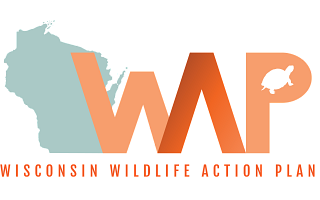Wisconsin Wildlife Action Plan
Planning for the future of Species of Greatest Conservation Need and their habitat

The Wisconsin Wildlife Action Plan (WWAP) focuses on the conservation of rare and declining species and their habitats. First published in 2005, it was updated in 2015 to satisfy funding eligibility through the State Wildlife Grant Program – the only nationwide program to prevent wildlife from becoming endangered. Over time, the WWAP has become a platform to help partners, organizations and individuals identify and implement important conservation actions to keep our natural resources healthy.
Updating The WWAP
The WWAP is due for its second 10-year update at the end of 2025. Opportunities to share knowledge and technical input will be available throughout the development of the 2025-2035 WWAP. Questions and comments on the proposed revisions below or other WWAP 2025-related topics can be sent at any time to the Wisconsin Wildlife Action Plan Coordinator email.
| Opportunities To Share Knowledge During Development Of The 2025-2035 WWAP Elements | Input Schedule |
|---|---|
| Species of greatest conservation need (SGCN) – species with low or declining populations that are in need of conservation. | Spring 2024 (proposed list) |
| Species of greatest information need (SIN/SGIN) – species that do not have sufficient information or that do not meet the criteria for SGCN but are of conservation concern were added to ranking and monitoring lists depending on their information needs. | Spring 2024 (proposed list) |
| Associated natural communities and habitats – needed to support healthy populations of SGCNs. | Fall 2024 (draft scores) |
| Conservation opportunity areas – places supporting SGCN habitat and significant ecological features that provide the best opportunity for successful conservation. | Winter 2025 |
| Conservation actions – to address issues or threats that affect SGCN or their habitat and measures for adapting these actions to new information or changing conditions. | Winter/Spring 2025 |
Draft 2025-2035 WWAP Elements
Proposed SGCN and SGIN Lists
Proposed 2025-2035 WWAP SGCN and SGINs are included in the table below.
Information on species range, occurrence, threats and trends were compiled to update Wisconsin state conservation ranks (SRanks) following NatureServe Conservation Status Assessment Methodology. Updated SRanks were used along with environmental vulnerability, Wisconsin status relative to the rest of their range, genetic diversity and other factors to identify SGCNs and SGINs for the 2025-2035 WWAP.
Draft Association Scores
To identify ecological priorities, degrees of association between SGCNs, natural communities and ecological landscapes were scored 0-3 following the directions and definitions in the guide to association scores. Association scores are based on literature sources, databases and mapping of known occurrences, habitat requirements and knowledge of current and historic populations of each species. Ecological priorities help direct conservation actions for SGCNs.
Please review the draft association scores for proposed 2025-2035 SGCNs using the score reports below or by downloading the association scores spreadsheet [Excel]. Return your input to the Wisconsin Wildlife Action Plan Coordinator.
Draft Ecological Landscape Association Score Reports
- Plant SGCN x Landscape Scores
- Vertebrate Animal SGCN x Landscape Scores
- Invertebrate Animal SGCN x Landscape Scores
- Natural Community/Habitat x Landscape Scores
Draft Natural Community Association Score Reports
- Plant SGCN x Community Scores
- Mammal SGCN x Community Scores
- Bird SGCN x Community Scores
- Amphibian And Reptile SGCN x Community Scores
- Fish SGCN x Community Scores
- Terrestrial Invertebrate SGCN x Community Scores
- Aquatic Insect SGCN x Community Scores
- Aquatic Invertebrate (Mussels and Crayfish) SGCN x Community Scores
